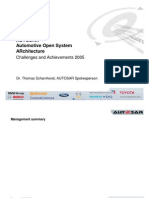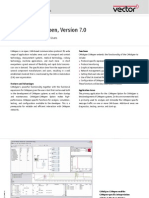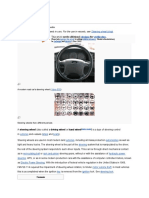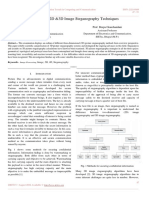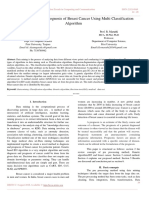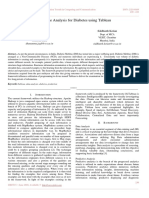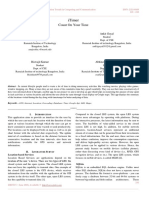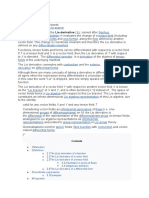SMS Based Home Automation Using CAN Protocol
Uploaded by
Editor IJRITCCSMS Based Home Automation Using CAN Protocol
Uploaded by
Editor IJRITCCInternational Journal on Recent and Innovation Trends in Computing and Communication
Volume: 4 Issue: 3
ISSN: 2321-8169
197 -202
______________________________________________________________________________________
SMS based Home Automation using CAN Protocol
Lakshmi Devi P
Assistant Professor, ECE Department
Channabasaveshwara Institute of Technology, Gubbi
Tumkur, Karnataka, India.
E-mail: lakshmi21devip@gmail.com
Abstract In this paper a SMS Based Home Automation System using CAN Protocol is presented. To save the much of the electrical energy,
implemented this design. By sitting at the same he/ she can control the lights and other devices without putting much effort. The concept is
implemented by making use CAN protocol, LPC 2129 etc. The experimental results show that this network system has high safety, stability with
practical significance, market value and it is affordable to a common people.
Keywords-CAN Protocol, LPC 2129, Automation system.
_________________________________________*****_________________________________________
I.
INTRODUCTION
SMS based home automation is a efficient way of saving
energy. The model is using as simple as calculator. The
efficient way of using the things in home could be done with
the help of CAN protocol, LPC 2129 etc.
A. Problem statement[12]
Technology has advanced so much in the last decade or two
that it has made life more efficient and comfortable. The
comfort of being able to take control of devices from one
particular location has become imperative as it saves a lot of
time and effort. Therefore there arises a need to do so in a
systematic manner which we have tried to implement with our
system. The system we have proposed is an extended approach
to automating a control system. With the advancement and
breakthroughs in technology over the years, the lives of people
have become more complicated and thus they have become
busier than before. With the adoption of our system, we can
gain control over certain things that required constant
attention. The application of our system comes in handy when
people who forget to do simple things such as turn ON or OFF
devices at their home or in their office, they can now do so
without their presence by the transmission of a simple text
message from their mobile phone. This development, we
believe, will ultimately save a lot of time especially when
people dont have to come back for simple things such as to
turn ON/OFF switches at their home or at their office once
they set out for their respective work. The objective of this
project is to develop a device that allows for a user to remotely
control and monitor multiple home/office appliances using a
cellular phone. This system will be a powerful and flexible
tool that will offer this service at any time, and from anywhere
with the constraints of the technologies being applied. Possible
target appliances include (but are not limited to) Light 1, Light
2, Pump, T.V, Fan anything with an electrical interface. The
proposed approach for designing this system is to implement
an ARM-7 control module that receives its instructions and
command from a cellular phone over the GSM network based
on CAN protocol. The ARM-7 then will carry out the issued
commands and then communicate with the given appliance.
For security purposes, a means of identification and user
authentication will be implemented, and will combine caller
identification.
II.
BLOCK DIAGRAM
Figure1: System Block Diagram
The figure1 is the simple block diagram. It is a simple
illustration of how we have implemented our idea and the
various parts involved in it. From the above representation, the
first GSM SIM 300 is used as a receiving section to which the
user sends text messages that contain commands and
instructions from the mobile station The LPC 2129 indicated
in the block diagram is an ARM-7 microprocessor. On
receiving SMS message microprocessor processes accordingly
to carry out specific operations. The relay driver (BUFFER
ULN2003) is used to drive the relay circuits which switches
the different appliances connected to the interface. The LCD is
used to indicate the status of the operation performed by the
microprocessor and also its inclusion makes the overall system
user-friendly.
Assuming that the control unit is powered and operating
properly, the process of controlling a device connected to the
interface will proceed through the following steps:
The remote user sends text messages including
commands to the GSM SIM 300.
197
IJRITCC | March 2016, Available @ http://www.ijritcc.org
_______________________________________________________________________________________
International Journal on Recent and Innovation Trends in Computing and Communication
Volume: 4 Issue: 3
ISSN: 2321-8169
197 -202
______________________________________________________________________________________
GSM receiver receives messages sent from the user cell
phone.
GSM receiver decodes the sent message and sends the
commands to the microprocessor.
Microprocessor issues commands to the appliances and
the devices connected will switch ON/OFF.
III.
CONTROLLER AREA NETWORK
The Controller Area Network (CAN) is a serial
communications protocol which efficiently supports distributed
real time control with a very high level of security. Its domain
of application ranges from high speed networks to low cost
multiplex wiring. In electronics, engine control units, sensors,
anti-skid-systems, Home automation system etc are connected
using CAN with bitrates up to 1 Mbit/s. At the same time it is
cost effective to build into compact body electronics, e.g. lamp
clusters electric windows etc. to replace the wiring harness
otherwise required.
A.Technology:
CAN is a multi-master broadcast serial bus standard
for connecting ECUs or Microcontrollers. Each node is able to
send and receive messages, but not simultaneously. A message
consists primarily of an ID (identifier), which represents the
priority of the message, and up to eight data bytes. The
improved CAN (CAN FD: FD-Flexible data rate) extends the
length of the data section to up to 64 bytes per frame. It is
transmitted serially onto the bus. This signal pattern is
encoded in non-return-to-zero (NRZ) and is sensed by all
nodes.
The devices that are connected by a CAN network are
typically sensors, actuators, and other control devices. These
devices are not connected directly to the bus, but through a
host processor and a CAN controller.
If the bus is idle which is represented by recessive level
(Logical 1), any node may begin to transmit. If two or more
nodes begin sending messages at the same time, the message
with the more dominant ID (which has the higher-order
dominant - i.e., zero - bit) will overwrite other nodes' less
dominant IDs, so that eventually (after this arbitration on the
ID.) only the dominant message remains and is received by all
nodes. This mechanism is referred to as priority based bus
arbitration. Messages with numerically smaller values of IDs
have higher priority and are transmitted first.
The CAN data link layer protocol is standardized in
ISO 11898-1 (2003). This standard describes mainly the data
link layer (composed of the logical link control (LLC)
sublayer and the media access control (MAC sublayer) and
some aspects of the physical layer of the OSI reference model.
B. Data transmission
CAN features an automatic arbitration-free
transmission. A CAN message that is transmitted with highest
priority will succeed and the node transmitting the lower
priority message will sense this and back off and wait.
This is achieved by CAN transmitting data through a
binary model of "dominant" bits and "recessive" bits where
dominant is a logical 0 and recessive is a logical 1. This means
open collector, or wired or physical implementation of the bus
(but since dominant is 0, this is sometimes referred to as wired
and). If one node transmits a dominant bit and another node
transmits a recessive bit then the dominant bit "wins" (a
logical AND between the two).
D. Can base frame format
A CAN base frame message begins with the start bit
called "Start of Frame (SOF)", this is followed by the
"Arbitration field" which consists of the identifier and the
"Remote Transmission Request (RTR)" bit used to distinguish
between the data frame and the data request frame called
remote frame. The following "Control field" contains the
"IDentifier Extension (IDE)" bit to distinguish between the
CAN base frame and the CAN extended frame, as well as the
"Data Length Code (DLC)" used to indicate the number of
following data bytes in the "Data field". If the message is used
as a remote frame, the DLC contains the number of requested
data bytes. The "Data field" that follows is able to hold up to 8
data byte. The integrity of the frame is guaranteed by the
following "Cyclic Redundant Check (CRC)" sum. The
"ACKnowledge (ACK) field" compromises the ACK slot and
the ACK delimiter. The bit in the ACK slot is sent as a
recessive bit and is overwritten as a dominant bit by those
receivers, which have at this time received the data correctly.
Correct messages are acknowledged by the receivers
regardless of the result of the acceptance test. The end of the
message is indicated by "End of Frame (EOF)". The
"Intermission Frame Space (IFS)" is the minimum number of
bits separating consecutive messages. Unless another station
starts transmitting, the bus remains idle after this.
E. Detecting and signaling errors
Unlike other bus systems, the CAN protocol does not
use acknowledgement messages but instead signals errors
immediately as they occur. For error detection the CAN
protocol implements three mechanisms at the message level
(data link layer: OSI layer 2).
If one or more errors are discovered by at least one station
using the above mechanisms, the current transmission is
aborted by sending an "error frame". This prevents other
stations from accepting the message and thus ensures the
consistency of data throughout the network. After transmission
of an erroneous message that has been aborted, the sender
automatically re-attempts transmission (automatic retransmission). Nodes may again compete for bus access.
However effective and efficient the method described may be,
in the event of a defective station it might lead to all messages
(including correct ones) being aborted. If no measures for self
monitoring were taken, the bus system would be blocked by
this. The CAN protocol therefore provides a mechanism to
distinguish sporadic errors from permanent errors and local
failures at the station. This is done by statistical assessment of
station error situations with the aim of recognizing a station's
own defects and possibly entering an operation mode in which
the rest of the CAN network is not negatively affected. This
may continue as far as the station switching itself off to
prevent other nodes messages erroneously from being
recognized as incorrect.
198
IJRITCC | March 2016, Available @ http://www.ijritcc.org
_______________________________________________________________________________________
International Journal on Recent and Innovation Trends in Computing and Communication
Volume: 4 Issue: 3
ISSN: 2321-8169
197 -202
______________________________________________________________________________________
IV.
FLOW CHART
Flowchart 1: Node 1
Flowchart 2: Node 2
199
IJRITCC | March 2016, Available @ http://www.ijritcc.org
_______________________________________________________________________________________
International Journal on Recent and Innovation Trends in Computing and Communication
Volume: 4 Issue: 3
ISSN: 2321-8169
197 -202
______________________________________________________________________________________
V.
RESULTS
A. Software Results
Software simulation is a program that allows the user to
observe an operation through simulation without actually
performing that operation. Here are some of the snapshots
taken during Software simulation. Before implementing it in
real time, software simulation is necessary to check the
functioning of the code.
Figure9: SMS ALL_ONN is send to SIM 300
Figure6: Snapshot shows turning ON of Light 1 in Section 1
Figure10: All LEDS are turned ON in Relay Board
Here the Commands are sent via SMS to a GSM
modem (GSM SIM 300); corresponding Device is turned
ON/OFF depending on the command received. We consider
the turning ON/OFF of the LEDs in relay board.
Figure7: Snapshot shows turning ON of FAN in Section 2
Figure11: SMS ALL_OFF is send to SIM 300
B. Hardware Results
Figure8: SMS ALL_ONN is send to SIM 300
Figure12: LCD displaying command received
200
IJRITCC | March 2016, Available @ http://www.ijritcc.org
_______________________________________________________________________________________
International Journal on Recent and Innovation Trends in Computing and Communication
Volume: 4 Issue: 3
ISSN: 2321-8169
197 -202
______________________________________________________________________________________
Here in the above figure14 S2_F1_1 command is sent to SIM
300 & LCD displaying command received and figure15 shows
that first LED is turned ON and to which FAN is connected
also turns ON.
We can compare the CAN bus with LIN as follows:
Figure13: All LEDS are turned OFF in Relay Board
Here in the above figure11 ALL_OFF command is
sent to SIM 300, in figure12 LCD displays ALL_OFF
command has been received and figure13 shows that all the
devices connected are turned OFF. In figure13 we can observe
that all LEDS are turned OFF. Similarly various outputs are
obtained for different commands sent. We have 12 commands
as follows
Table2: Comparison between LIN and CAN
Table1: Command Table
Figure14: SMS S2_F1_1 is send to SIM 300 & LCD
displaying command received
Figure15: First LED is turned ON in Relay Board
CONCLUSION
Thus an efficient Home automation system using CAN
Protocol is designed and implemented. The components used in
this idea are cost efficient, thus reducing the budget which can
be affordable by a common man. In this concept 2048 nodes
can be connected, which increases a wide range of devices that
can be interfaced. The data transfer rate is 1Mb/sec which is
very efficient in time. Remotely by a touch of a button status of
the home can be known or monitored, meanwhile necessary
actions can be taken by a single command across the globe.
Since CAN bus is used as a communication of a distributed
control network, CAN bus provides high safety against EMC
problems, thus increasing safety. CAN gives minimized
radiation and high irradiation stability. It also overcomes the
problem of existing technologies like Insteon, which uses dualband mesh home area networking topology where one node is
master and other are slaves. If master node fails whole system
goes down. Whereas we have used CAN bus (Bus topology),
where each node acts as a master and each as a slave. Failure of
any node doesnt affect other nodes keeping the system safe
and stable. The system is secured for access from outside and
protected by configuring the user mobile number through GT
commands at the SIM 300. The users are expected to register
their mobile numbers to the GSM SIM 300. This adds
protection from unauthorized accesses.
FUTURE SCOPE
Since we have used Advanced ARM 7 LPC2129
Microprocessor which is of 32 bit, we can use speech signals to
control the system along with the SMS. The system can be
integrated with various sensors like First Alert 3120B to detect
smoke and alert the user as well as Fire fighter to take further
steps, PIR sensors to auto turn ON/OFF devices when the user
is at home, because sending SMS is not convenient when the
user is at home itself. More complex protocols and algorithms
like Flex Ray can be implemented as microprocessor used is of
32 bits.
201
IJRITCC | March 2016, Available @ http://www.ijritcc.org
_______________________________________________________________________________________
International Journal on Recent and Innovation Trends in Computing and Communication
Volume: 4 Issue: 3
ISSN: 2321-8169
197 -202
______________________________________________________________________________________
REFERENCES
[1]
[2]
[3]
[4]
[5]
[6]
[7]
[8]
[9]
[10]
[11]
[12]
R.Piyare, M.Tazil, Bluetooth Based Home Automation Using
Cell Phone, 2011 IEEE 15th International Symposium on
Consumer Electronics.
N. Sriskanthan and Tan Karande, Bluetooth Based Home
Automation Systems, Journal of Microprocessors and
Microsystems, Vol. 26, pp.281-289, 2002.
Maqbool S, Linfoot S, Gow. J, Marshall. G. A novel
security/home automation gateway for domestic residences
IEEEexplore 9-13 Jan. 2010
Ibrahim Geha, Kfoury Elie, and Ashraf Jaafar SAFE HOME
An Advanced Home Security System, Department of Mechanical Engineering American University of Beirut Beirut, Lebanon,
Volume 2, 2009 , pp 234-239.
Malik Sikandar Hayat Khiyal, Aihab Khan, and Erum Shehzadi
SMS Based Wireless Home Appliance Control System (HACS)
for Automating Appliances and Security, Issues in Informing
Science and Information Technology Volume 6, 2009 , pp 887894.
LPC
2129
Data
sheet
[Online].
Available:
http://www.keil.com/dd/docs/datashts/philips/lpc2119_2129.pdf
AT Commands, GSM AT Commands set [Online]. Available:
http://www.engineersgarage.com/tutorials/atcommands?page=4
Claire Maternaghan, The Homer Home Automation System
Department of Computing Science and Mathematics University
of Stirling Technical Report CSM-187 ISSN 1460-9673
CAN
2.0
Data
sheet
[Online].Available:
http://esd.cs.ucr.edu/webres/can20.pdf
http://www.ssspl.org/uploads/Products/Pdf/IntegratedHomeAuto
mation.pdf
http://shaunsalzberg.com/medialab/homemaestro
http://www.slideshare.net/avinashkannojianmh/gsm-baseddevices-control-system-project-report"
202
IJRITCC | March 2016, Available @ http://www.ijritcc.org
_______________________________________________________________________________________
You might also like
- Motor Speed Control Based On Temperature Using Can ProtocolNo ratings yetMotor Speed Control Based On Temperature Using Can Protocol4 pages
- Design of Vehicle Bus Data Acquisition and Fault Diagnosis System Using CANNo ratings yetDesign of Vehicle Bus Data Acquisition and Fault Diagnosis System Using CAN4 pages
- Wireless Communications Security: Solutions for the Internet of ThingsFrom EverandWireless Communications Security: Solutions for the Internet of ThingsNo ratings yet
- Intelligent Transport Systems (ITS) Cooperative ITS (C-ITS) Release 1 Communications ArchitectureNo ratings yetIntelligent Transport Systems (ITS) Cooperative ITS (C-ITS) Release 1 Communications Architecture44 pages
- PLC Based Traffic Control System With Emergency Vehicle Detection and ManagementNo ratings yetPLC Based Traffic Control System With Emergency Vehicle Detection and Management7 pages
- An-InD-1-001 CANoe CANalyzer As Diagnostic ToolsNo ratings yetAn-InD-1-001 CANoe CANalyzer As Diagnostic Tools31 pages
- Autosar Automotive Open System Architecture: Challenges and Achievements 2005100% (2)Autosar Automotive Open System Architecture: Challenges and Achievements 200525 pages
- 4-14 - p18 - Tips-And-Tricks-For-The-Use-Of-Capl-Part 3 - Lobmeyer - MarktlNo ratings yet4-14 - p18 - Tips-And-Tricks-For-The-Use-Of-Capl-Part 3 - Lobmeyer - Marktl4 pages
- Future Intelligent Mobility With Adaptive AUTOSAR - Transforming Vehicle E/E ArchitectureNo ratings yetFuture Intelligent Mobility With Adaptive AUTOSAR - Transforming Vehicle E/E Architecture25 pages
- dSPACENews2006-3 AutomationDesk en Pn422No ratings yetdSPACENews2006-3 AutomationDesk en Pn4222 pages
- Automotive Communication Protocols - Preparing For The Future - AutomotiveNo ratings yetAutomotive Communication Protocols - Preparing For The Future - Automotive4 pages
- Automotive Application Guide 2014 - BR PDF100% (1)Automotive Application Guide 2014 - BR PDF60 pages
- CAPL 3 CANNewsletter 201411 PressArticle enNo ratings yetCAPL 3 CANNewsletter 201411 PressArticle en2 pages
- Mastering Rtos: Hands On Freertos and Stm32Fx With DebuggingNo ratings yetMastering Rtos: Hands On Freertos and Stm32Fx With Debugging348 pages
- Controller Area Network: Submitted By:Chandra Shekar.I.G Dept of E&C 1NH02EC010 Nhce100% (2)Controller Area Network: Submitted By:Chandra Shekar.I.G Dept of E&C 1NH02EC010 Nhce22 pages
- Full Agenda CANoe - Ethernet Compact OnlineNo ratings yetFull Agenda CANoe - Ethernet Compact Online1 page
- A Case Study On Power Train in Supra 2011 and 2012100% (1)A Case Study On Power Train in Supra 2011 and 201211 pages
- Flash en Flex Ray ElektronikAutomotive 200711 Press Article enNo ratings yetFlash en Flex Ray ElektronikAutomotive 200711 Press Article en15 pages
- 25977-Automobile Sensors May Usher in Self Driving Cars PDFNo ratings yet25977-Automobile Sensors May Usher in Self Driving Cars PDF6 pages
- Steering Wheel: This Article Is About Steering Wheels in Cars. For The Use in Vessels, See100% (2)Steering Wheel: This Article Is About Steering Wheels in Cars. For The Use in Vessels, See7 pages
- Vector CANoe and CANalyzer Are Two Powerful Software Tools For The DevelopmentNo ratings yetVector CANoe and CANalyzer Are Two Powerful Software Tools For The Development1 page
- Fault Tolerance in Automotive Systems - ReportNo ratings yetFault Tolerance in Automotive Systems - Report10 pages
- XCP or "Universal Measurement and Calibration Protocol" Is A Network ProtocolNo ratings yetXCP or "Universal Measurement and Calibration Protocol" Is A Network Protocol2 pages
- Enabling 100 Gigabit Ethernet Implementing PCS Lanes: White PaperNo ratings yetEnabling 100 Gigabit Ethernet Implementing PCS Lanes: White Paper12 pages
- Types of Automotive Braking Systems: Brake ComponentsNo ratings yetTypes of Automotive Braking Systems: Brake Components5 pages
- FlexRay and its Applications: Real Time Multiplexed NetworkFrom EverandFlexRay and its Applications: Real Time Multiplexed NetworkNo ratings yet
- Channel Estimation Techniques Over MIMO-OFDM SystemNo ratings yetChannel Estimation Techniques Over MIMO-OFDM System4 pages
- A Review of 2D &3D Image Steganography TechniquesNo ratings yetA Review of 2D &3D Image Steganography Techniques5 pages
- A Review of Wearable Antenna For Body Area Network ApplicationNo ratings yetA Review of Wearable Antenna For Body Area Network Application4 pages
- A Review of 2D &3D Image Steganography TechniquesNo ratings yetA Review of 2D &3D Image Steganography Techniques5 pages
- A Study of Focused Web Crawling TechniquesNo ratings yetA Study of Focused Web Crawling Techniques4 pages
- IJRITCC Call For Papers (October 2016 Issue) Citation in Google Scholar Impact Factor 5.837 DOI (CrossRef USA) For Each Paper, IC Value 5.075No ratings yetIJRITCC Call For Papers (October 2016 Issue) Citation in Google Scholar Impact Factor 5.837 DOI (CrossRef USA) For Each Paper, IC Value 5.0753 pages
- Importance of Similarity Measures in Effective Web Information RetrievalNo ratings yetImportance of Similarity Measures in Effective Web Information Retrieval5 pages
- Channel Estimation Techniques Over MIMO-OFDM SystemNo ratings yetChannel Estimation Techniques Over MIMO-OFDM System4 pages
- A Review of Wearable Antenna For Body Area Network ApplicationNo ratings yetA Review of Wearable Antenna For Body Area Network Application4 pages
- Diagnosis and Prognosis of Breast Cancer Using Multi Classification AlgorithmNo ratings yetDiagnosis and Prognosis of Breast Cancer Using Multi Classification Algorithm5 pages
- Predictive Analysis For Diabetes Using Tableau: Dhanamma Jagli Siddhanth KotianNo ratings yetPredictive Analysis For Diabetes Using Tableau: Dhanamma Jagli Siddhanth Kotian3 pages
- Hybrid Algorithm For Enhanced Watermark Security With Robust DetectionNo ratings yetHybrid Algorithm For Enhanced Watermark Security With Robust Detection5 pages
- BUSINESS DIARY - An Interactive and Intelligent Platform For SME'sNo ratings yetBUSINESS DIARY - An Interactive and Intelligent Platform For SME's3 pages
- Safeguarding Data Privacy by Placing Multi-Level Access RestrictionsNo ratings yetSafeguarding Data Privacy by Placing Multi-Level Access Restrictions3 pages
- An Approach For Power Control in Vehicular Adhoc Network For Catastrophe MessageNo ratings yetAn Approach For Power Control in Vehicular Adhoc Network For Catastrophe Message7 pages
- Image Restoration Techniques Using Fusion To Remove Motion BlurNo ratings yetImage Restoration Techniques Using Fusion To Remove Motion Blur5 pages
- Paper On Design and Analysis of Wheel Set Assembly & Disassembly Hydraulic Press MachineNo ratings yetPaper On Design and Analysis of Wheel Set Assembly & Disassembly Hydraulic Press Machine4 pages
- Learn 50 JLPT-N5 Vocab With Pictures: by Mario Hayashi, Kuma LearnNo ratings yetLearn 50 JLPT-N5 Vocab With Pictures: by Mario Hayashi, Kuma Learn29 pages
- A Survey of Sassanian Silver Coins Found in ChinaNo ratings yetA Survey of Sassanian Silver Coins Found in China2 pages
- 2.1 Lab - Setting Up The Lab EnvironmentNo ratings yet2.1 Lab - Setting Up The Lab Environment5 pages
- Lie Derivative: From Wikipedia, The Free EncyclopediaNo ratings yetLie Derivative: From Wikipedia, The Free Encyclopedia19 pages
- Teacher's Book: With Digital Resources and Assessment PackageNo ratings yetTeacher's Book: With Digital Resources and Assessment Package38 pages
- Biu2032 English Proficiency 3 SEMESTER 2 SESSION 2019/2020 Rubric For Cause and Effect EssayNo ratings yetBiu2032 English Proficiency 3 SEMESTER 2 SESSION 2019/2020 Rubric For Cause and Effect Essay3 pages
- Name - Spotlight 7 Module 1. Test.: 1. Match The Words/phrases To Their DefinitionNo ratings yetName - Spotlight 7 Module 1. Test.: 1. Match The Words/phrases To Their Definition3 pages
- 2MS Second Term Exam Harraza - by Teacher Amel Aouabed 2018No ratings yet2MS Second Term Exam Harraza - by Teacher Amel Aouabed 20183 pages
- Success in Teaching Pronunciation To Levels 1 & 2100% (4)Success in Teaching Pronunciation To Levels 1 & 231 pages
- Software Mining Repository Notes Unit 1No ratings yetSoftware Mining Repository Notes Unit 110 pages
- Motor Speed Control Based On Temperature Using Can ProtocolMotor Speed Control Based On Temperature Using Can Protocol
- Design of Vehicle Bus Data Acquisition and Fault Diagnosis System Using CANDesign of Vehicle Bus Data Acquisition and Fault Diagnosis System Using CAN
- Wireless Communications Security: Solutions for the Internet of ThingsFrom EverandWireless Communications Security: Solutions for the Internet of Things
- Intelligent Transport Systems (ITS) Cooperative ITS (C-ITS) Release 1 Communications ArchitectureIntelligent Transport Systems (ITS) Cooperative ITS (C-ITS) Release 1 Communications Architecture
- PLC Based Traffic Control System With Emergency Vehicle Detection and ManagementPLC Based Traffic Control System With Emergency Vehicle Detection and Management
- Autosar Automotive Open System Architecture: Challenges and Achievements 2005Autosar Automotive Open System Architecture: Challenges and Achievements 2005
- 4-14 - p18 - Tips-And-Tricks-For-The-Use-Of-Capl-Part 3 - Lobmeyer - Marktl4-14 - p18 - Tips-And-Tricks-For-The-Use-Of-Capl-Part 3 - Lobmeyer - Marktl
- Future Intelligent Mobility With Adaptive AUTOSAR - Transforming Vehicle E/E ArchitectureFuture Intelligent Mobility With Adaptive AUTOSAR - Transforming Vehicle E/E Architecture
- Automotive Communication Protocols - Preparing For The Future - AutomotiveAutomotive Communication Protocols - Preparing For The Future - Automotive
- Mastering Rtos: Hands On Freertos and Stm32Fx With DebuggingMastering Rtos: Hands On Freertos and Stm32Fx With Debugging
- Controller Area Network: Submitted By:Chandra Shekar.I.G Dept of E&C 1NH02EC010 NhceController Area Network: Submitted By:Chandra Shekar.I.G Dept of E&C 1NH02EC010 Nhce
- A Case Study On Power Train in Supra 2011 and 2012A Case Study On Power Train in Supra 2011 and 2012
- Flash en Flex Ray ElektronikAutomotive 200711 Press Article enFlash en Flex Ray ElektronikAutomotive 200711 Press Article en
- 25977-Automobile Sensors May Usher in Self Driving Cars PDF25977-Automobile Sensors May Usher in Self Driving Cars PDF
- Steering Wheel: This Article Is About Steering Wheels in Cars. For The Use in Vessels, SeeSteering Wheel: This Article Is About Steering Wheels in Cars. For The Use in Vessels, See
- Vector CANoe and CANalyzer Are Two Powerful Software Tools For The DevelopmentVector CANoe and CANalyzer Are Two Powerful Software Tools For The Development
- XCP or "Universal Measurement and Calibration Protocol" Is A Network ProtocolXCP or "Universal Measurement and Calibration Protocol" Is A Network Protocol
- Enabling 100 Gigabit Ethernet Implementing PCS Lanes: White PaperEnabling 100 Gigabit Ethernet Implementing PCS Lanes: White Paper
- Types of Automotive Braking Systems: Brake ComponentsTypes of Automotive Braking Systems: Brake Components
- FlexRay and its Applications: Real Time Multiplexed NetworkFrom EverandFlexRay and its Applications: Real Time Multiplexed Network
- Industrial internet of things Standard RequirementsFrom EverandIndustrial internet of things Standard Requirements
- IoT Business Solutions Complete Self-Assessment GuideFrom EverandIoT Business Solutions Complete Self-Assessment Guide
- Channel Estimation Techniques Over MIMO-OFDM SystemChannel Estimation Techniques Over MIMO-OFDM System
- A Review of Wearable Antenna For Body Area Network ApplicationA Review of Wearable Antenna For Body Area Network Application
- IJRITCC Call For Papers (October 2016 Issue) Citation in Google Scholar Impact Factor 5.837 DOI (CrossRef USA) For Each Paper, IC Value 5.075IJRITCC Call For Papers (October 2016 Issue) Citation in Google Scholar Impact Factor 5.837 DOI (CrossRef USA) For Each Paper, IC Value 5.075
- Importance of Similarity Measures in Effective Web Information RetrievalImportance of Similarity Measures in Effective Web Information Retrieval
- Channel Estimation Techniques Over MIMO-OFDM SystemChannel Estimation Techniques Over MIMO-OFDM System
- A Review of Wearable Antenna For Body Area Network ApplicationA Review of Wearable Antenna For Body Area Network Application
- Diagnosis and Prognosis of Breast Cancer Using Multi Classification AlgorithmDiagnosis and Prognosis of Breast Cancer Using Multi Classification Algorithm
- Predictive Analysis For Diabetes Using Tableau: Dhanamma Jagli Siddhanth KotianPredictive Analysis For Diabetes Using Tableau: Dhanamma Jagli Siddhanth Kotian
- Hybrid Algorithm For Enhanced Watermark Security With Robust DetectionHybrid Algorithm For Enhanced Watermark Security With Robust Detection
- BUSINESS DIARY - An Interactive and Intelligent Platform For SME'sBUSINESS DIARY - An Interactive and Intelligent Platform For SME's
- Safeguarding Data Privacy by Placing Multi-Level Access RestrictionsSafeguarding Data Privacy by Placing Multi-Level Access Restrictions
- An Approach For Power Control in Vehicular Adhoc Network For Catastrophe MessageAn Approach For Power Control in Vehicular Adhoc Network For Catastrophe Message
- Image Restoration Techniques Using Fusion To Remove Motion BlurImage Restoration Techniques Using Fusion To Remove Motion Blur
- Paper On Design and Analysis of Wheel Set Assembly & Disassembly Hydraulic Press MachinePaper On Design and Analysis of Wheel Set Assembly & Disassembly Hydraulic Press Machine
- Learn 50 JLPT-N5 Vocab With Pictures: by Mario Hayashi, Kuma LearnLearn 50 JLPT-N5 Vocab With Pictures: by Mario Hayashi, Kuma Learn
- Lie Derivative: From Wikipedia, The Free EncyclopediaLie Derivative: From Wikipedia, The Free Encyclopedia
- Teacher's Book: With Digital Resources and Assessment PackageTeacher's Book: With Digital Resources and Assessment Package
- Biu2032 English Proficiency 3 SEMESTER 2 SESSION 2019/2020 Rubric For Cause and Effect EssayBiu2032 English Proficiency 3 SEMESTER 2 SESSION 2019/2020 Rubric For Cause and Effect Essay
- Name - Spotlight 7 Module 1. Test.: 1. Match The Words/phrases To Their DefinitionName - Spotlight 7 Module 1. Test.: 1. Match The Words/phrases To Their Definition
- 2MS Second Term Exam Harraza - by Teacher Amel Aouabed 20182MS Second Term Exam Harraza - by Teacher Amel Aouabed 2018




















